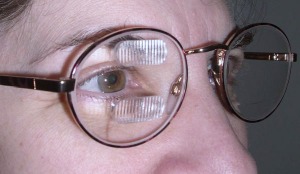 The
simple definition of a prism is a solid object that has the same
cross-section along the entire length of its shape. When you cut
straight across an object, the cut portion is called a cross-section.
Draw any shape using straight lines. Now use your imagination to see it
extend upward and that is a prism.
The
simple definition of a prism is a solid object that has the same
cross-section along the entire length of its shape. When you cut
straight across an object, the cut portion is called a cross-section.
Draw any shape using straight lines. Now use your imagination to see it
extend upward and that is a prism.In eyeglasses, prisms are used primarily for double vision, positional correction, or convergence correction.
Prism eyeglasses are enough to correct these abnormalities if the person has nearly normal vision in their level of nearsightedness or farsightedness. However, if one of the eyes has greatly reduced vision or blindness, there could be physical or neurological issues causing the diplopia. This would then require surgery to repair the eye muscles in addition to the use of the corrective prism lenses.
Standard eyeglasses usually correct two types of eyesight errors, or a combination of both: focal distance (near or farsightedness), or unusual curving of the cornea (astigmatism and cylinder).
Prism lenses are necessary to aid in getting the eyes to work together. One or both eyes tend to pull up, down, to the left, or to the right. The use of prism in the lenses tricks the brain into thinking the eyes are working together by shifting the image only slightly up, down, left, or right.
Recently, prisms have been helping people with hemianopia. This condition causes blindness in half of the visual field in both eyes—either the left or the right field. It is most common to brain injury and stroke victims, and sometimes each eye is defective in exactly the same way. Other times, each eye is affected differently. Less common is the lack of sight in the upper or lower fields of vision.
Quadrantanopia is the same condition, but one quarter of the eye is blind. The particular field affected can be left, right, upper, or lower, and can also be the same or different in each eye.
Since peripheral vision is most often affected, prisms are ground into the lenses to show an image outside the range of sight, simply by placing the prisms within the viewer’s sighted area. This alerts them to something which would normally not be seen and they can then turn to observe it more closely, thereby avoiding running into people or objects simply from lack of seeing them.
Read the Original article on GlassesCrafter.com
About Us
20/20 Eyeglass Superstore carries over 4000 quality and designer frames. Accordingly, our tagline is, “A Frame for Every Face and a Price for Any Budget”. We pride ourselves on assisting Orlando residents find everything they need when it comes to vision care. From prescription lenses to progressives, we can assist you find exactly what you’re looking for.
No comments:
Post a Comment